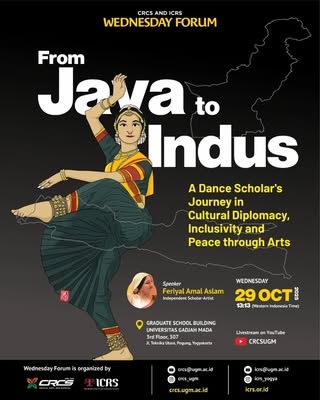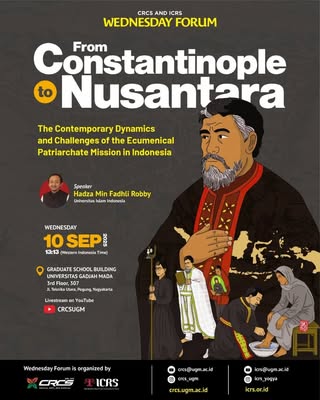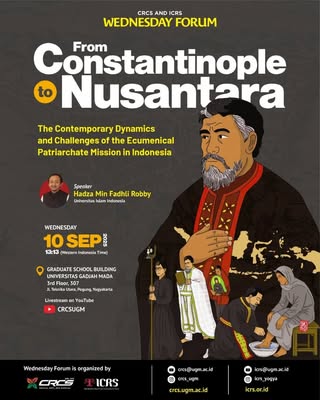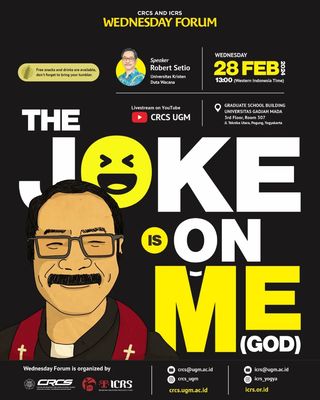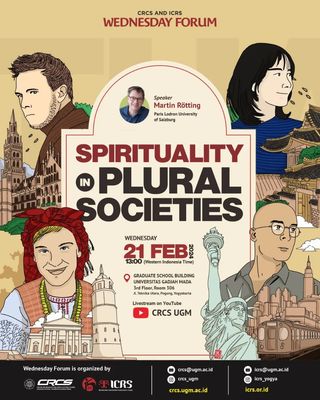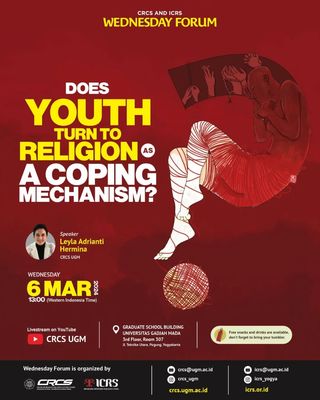
Anthon Jason
Azis Anwar Fachruddin’s Wednesday Forum presentation, entitled “Agama and Din in Precolonial Islamic Malay and Javanese Texts,” critically interrogates the now-popular thesis that “religion” (agama in Malay/Indonesian) is simply a modern Western invention, exported to the colonies and imposed on local societies. Azis positions himself squarely against the universalist strand of this argument, as articulated by deconstructionist and postcolonial theorists, by presenting concrete evidence from 16th- and 17th-century Malay and Javanese texts that demonstrate the indigenous of a reified concept of “religion” within the region, particularly in its Islamic articulations.
Azis began by situating his presentation from his dissertation’s main question: Why did Muslim elites in Indonesia, especially between the 1950s and 1970s, refuse to recognize indigenous belief systems such as Kebatinan as equal to “agama” (religion)? He noted that the prevailing answer within Western religious studies is that “religion” itself is a modern Western invention, imposed by colonial powers and selectively appropriated by local authorities to determine what counts as “official” religion. To establish the dominance of these ideas, He read several quotations from textbook authorities that describe “agama” as having been adopted under colonial influence, equated with the Western concept of “religion,” and utilized by the state to regulate belief and tradition.
Background: The “Religion Is Modern Western Invention” Thesis
Azis opens by reviewing the dominant academic paradigm in Western religious studies and critical theory, noting that many scholars argue that “religion” as a discrete, systematized category is a product of post-Enlightenment European thought and institutional power. Some of these arguments are echoed in a range of literature, with some scholars claiming, as Azis quotes, “the terms and concepts corresponding to religion do not appear in the literature of non-western cultures until after those cultures first encountered European Christians.”
According to this universalist critique, the indigenous term agama (from Sanskrit) was only made to function as “religion” after colonial intervention, as a translation for the Western concept. The modern state, these theorists assert, subsequently entrenched “agama” as a legal and social category—so that, for example, official definitions of agama in Indonesia today supposedly reflect a Western genealogy, not an indigenous tradition.
Refuting the Universalist Claim: Agama, Din, and Local Textual Evidence
Azis’s central argument, supported by precolonial textual analysis, states that such claims are at best incomplete and at worst, empirically false for the Indonesian-Malay context. Drawing on both Islamic and local sources, Azis asserts that the concept of dīn was already thoroughly conceptualized in premodern Islamic civilization, and that its translation as agama appears organically, not as an imposed template.
1. Dīn in Islamic Tradition
Azis cites recent Islamicist scholarship, notably Abbasi (2021), confirming that dīn in premodern Islamic intellectual history is not just a reference to piety or spiritual orientation but refers specifically to systematic, identifiable traditions—often in the plural (adyan). Thus, “din was already a reified concept, used as a taxonomic device to classify bodies of beliefs and practices, distinguishing Islam from other religions and sects.”
He then meticulously traces how this logic appears in Southeast Asian works even prior to colonial arrival. “The claim that there was no native concept of religion before Western hegemony thus needs significant qualification—at least in the case of the Malay archipelago,” Azis argues.
2. Translating Dīn: The Evidence from Malay and Javanese Texts
Azis’s empirical contribution comes through philological examination:
- In one of the earliest known interlinear Malay translations—the ‘Aqa’id of Najmuddin ‘Umar al-Nasafi (a foundational 12th-century Sunni theological work) produced in Aceh in 1590—the concept dīn is systematically translated as agama, not after Dutch colonization but decades before significant Western presence.
- The seminal Qur’anic commentary in Malay by Abdul Rauf al-Singkili (d. 1693) also renders every occurrence of din as agama. In Surah Al-Kafirun, the plural usage—“For you your dīn, for me my dīn”—is rendered as “untukmu agamamu, untukku agamaku,” presupposing comparability and reification between distinct traditions.
- The first Malay treatise on comparative religion, Nuruddin al-Raniri’s “Al-Muntakhib fi Ma’rifat al-Adyan” (The Exposition on the Knowledge of All Religions), explicitly multiplies dīn using the Arabic plural adyan, confirming that “religious traditions” were already being compared and catalogued as bounded entities. In Raniri’s own Malay, he refers to these as agamas, further reinforcing the idea that Indo-Malay writers used agama taxonomically.
- In Javanese, the same logic is visible. Early manuscripts, such as the Serat Kropak Ferrara, use agama not only for Islam but also for Hindu-Buddhist and “Javanese” traditions, for instance “agama Jawa,” indicating that local categories of tradition were being formally recognized and theorized as comparable entities.
These translations and enumerations are not late impositions but contemporaneous with the global Islamic scholarly world, which, as Azis notes, was itself already employing the plural adyan as a taxonomic and sometimes comparative device.
3. The Philological Argument for Reification
Quoting Smith’s own criterion, Azis observes, “One indication to say that a concept has been reified is if the term has a plural form.” He presents examples from classical Arabic literature, medieval Malay commentaries, and Javanese palm-leaf manuscripts showing not only dīn and agama in the singular, but their explicit plural use—adyan and, analogously, aggregated references to agamas. This, in his view, amounts to strong evidence for precolonial reification: “agama functions similarly as the modern concept of religion, as a genus to categorize subordinate species.”
Addressing the Nuances: Is Universalist Critique Totally Wrong?
Azis displays a commendable degree of academic humility in his acknowledgement of the intricate political and regional complexities of the issue at hand. Responding to post-presentation critiques (including references to Wilfred Cantwell Smith’s “exception” for Islam and British India as a “true” case of colonial invention) he clarifies: the European colonial state played a decisive role in crystallizing categories of religion in South Asia (e.g., the forging of “Hinduism” as a singular, reified object), but this does not mean every non-Western context follows the same trajectory. “The universalist claim, then, at the very least requires significant qualification,” Azis notes. In his view, the Muslim world is an exception due to the imperial and taxonomic needs of Islamic empires, which “would require a concept to regulate their subjects’ traditions and belief system, and dīn would be one example.”
Quoting Wilfred Cantwell Smith directly: “Islam is the closest to ‘religion’ before religion”—meaning that dīn in the Islamic intellectual tradition was conceptualized as a generic category in a way that Latin religio was not until modernity. As for Malay and Javanese, they inherited, translated, and ultimately indigenized this logic, such that when Islam entered the archipelago, these societies already had both the Sanskrit agama (for bodies of teaching) and the political-administrative context to receive and rework the category.
Alternative Etymologies and Local Meanings
Azis takes care to differentiate popular and scholarly narratives regarding the origin and meaning of agama. He notes that widespread beliefs among Indonesian students that agama originally means “salvation” or “truth” (derived from folk etymologies like “a-gama” = “not chaotic” or “not dark”) have no foundation in the philological evidence. Instead, serious research aligns with the definition of agama in medieval Indic culture as “a collection of revealed teachings handed down across generations, typically in written scriptural form”—which closely parallels the translation of dīn as “a revealed tradition with scripture and law.”
It is for this reason, Azis explains, that agama became the preferred term in Malay and Javanese, rather than alternatives like keyakinan (beliefs), tradisi, or adat (custom).
The Context of Islamization and Syncretism
The archipelago’s embrace of “agama” as both a scriptural and legal category is further contextualized in its history of Islamization. Azis explores how early Malay and Javanese Islamic texts, while sometimes fiercely polemical in condemning pre-Islamic or “pagan” practices, also evince conceptual continuity with preexisting Hindu-Buddhist traditions that used agama as a scriptural category. Thus, both polemical and dialogical uses coexist, revealing the strategic flexibility of local ruling elites and scholars in making sense of religious difference.Notably, Azis references the complex politics of conversion and comparison in texts like the Kropak Ferrara, where boundaries are drawn but multiple religions are already reified and compared.
The Theoretical Payoff: Beyond Easy Universalism
Azis’s intervention, ultimately, is both theoretical and methodological. He warns against “sloganistic” academic critique that treats “religion” as always and everywhere a colonial artifact, cautioning that such a totalizing stance blinds scholars to historical nuance, philological evidence, and the self-conscious agency of Asian polities and intellectuals. “The big thesis in religious studies that religion is a Western modern invention, to conclude this presentation, needs significant qualification at the very least—if not to be described as wrong,” he argues.
Quoting from his presentation’s abstract, he states, “This is not to exonerate colonial regimes from their classificatory violence; it simply restores historical precision and recognizes the archipelago’s own long-standing conceptual labor in naming and organizing religious difference.”
In closing, Azis urges the field toward a more regionally sensitive and historically grounded social science of religion. For Indonesia, as for Asian Muslim societies broadly, understanding agama as a living, evolving category—one rooted equally in Islamic and indigenous taxonomies—provides a firmer foundation for future legal, political, and civic approaches to religious diversity. He calls for continued archival, philological, and comparative research that foregrounds indigenous conceptual contributions, contests the lazy binary of “Western colonizer” versus “passive local,” and acknowledges the dense, dialogical evolution of key terms in the archipelago’s own vocabulary of religious difference.




